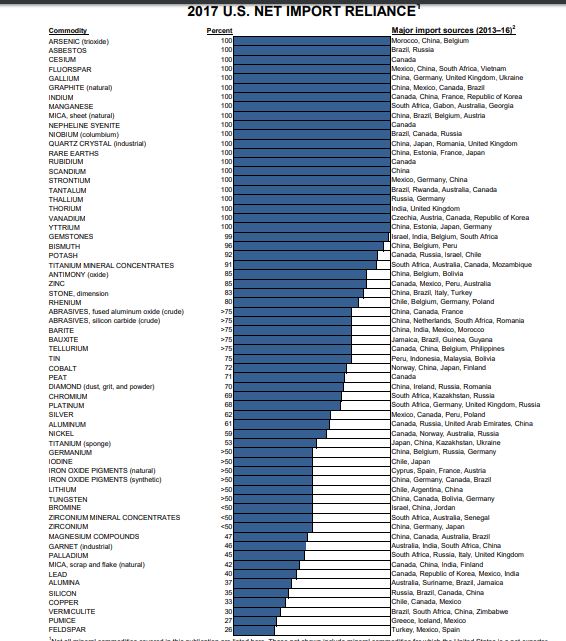
The U.S. Geological Survey has just released its annual summary of non-fuel mineral production in the U.S. for 2017. The estimated total value of domestically-mined, non-fuel minerals in the United States was $75.2 billion, a 6% increase from 2016.
The estimated value of metals production increased 12% to $26.3 billion. Principal contributors to the total value of metal mine production in 2017 were gold (38%), copper (30%), iron ore (12%), and zinc (8%).
The total value of industrial minerals production was $48.9 billion, a 3% increase from that of 2016. The main industrial minerals were crushed stone (31%), cement (20%), and construction sand and gravel (16%).
These mineral materials were, in turn, consumed by downstream industries to produce an estimated value of $2.94 trillion for the U.S. economy in 2017, a 3.5% increase from 2016. If you add in manufacturing which uses imported mineral products as well, the value of non-fuel minerals to the U.S. gross domestic product was $19.3 trillion in 2017.
Nevada captured first place in U.S. non-fuel mineral mining in 2017 with a production value of $8.68 billion, mainly from Gold.
Arizona was the second largest producer with a production value of $6.61, mainly from copper. Mike Conway of the Arizona Geological Survey summed up the Arizona 2017 highlights as follows:
- 1st in copper production with ~ 68% of domestic production.
- 2nd in gemstone production after Oregon and ahead of Idaho.
- 5th in producing sand and gravel for construction.
- Other industrial minerals produced in Arizona in 2017: gypsum, dimension stone, clay, zeolites, bentonite, perlite, and salt.
- 6th in production of zeolites, and the only producer of chabazite.
- Arizona joins six other states involved in helium production.
- Arizona is one of five states with molybdenum production.
- Arizona is a leader in Rhenium production with four of the six operations in the U.S.
The U.S. Geological Survey notes:
In 2017, U.S. production of 13 mineral commodities was valued at more than $1 billion each. These were, in decreasing order of value, crushed stone, gold, cement, copper, construction sand and gravel, industrial sand and gravel, iron ore, lime, zinc, phosphate rock, salt, soda ash, and clays (all types).
In 2017, 11 States each produced more than $2 billion worth of nonfuel mineral commodities. These States were, in descending order of production value, Nevada, Arizona, Texas, Alaska, California, Minnesota, Florida, Utah, Missouri, Michigan, and Wyoming.
The US Geological Survey report shows that the U.S. is 100% reliant on imports for 22 minerals.
A note on reserves and resources from the U.S. Geological Survey:
Reserves data are dynamic. They may be reduced as ore is mined and (or) the feasibility of extraction diminishes, or more commonly, they may continue to increase as additional deposits (known or recently discovered) are developed, or currently exploited deposits are more thoroughly explored and (or) new technology or economic variables improve their economic feasibility. Reserves may be considered a working inventory of mining companies’ supplies of an economically extractable mineral commodity. As such, the magnitude of that inventory is necessarily limited by many considerations, including cost of drilling, taxes, price of the mineral commodity being mined, and the demand for it. Reserves will be developed to the point of business needs and geologic limitations of economic ore grade and tonnage. For example, in 1970, identified and undiscovered world copper resources were estimated to contain 1.6 billion metric tons of copper, with reserves of about 280 million tons of copper. Since then, almost 520 million tons of copper have been produced worldwide, but world copper reserves in 2017 were estimated to be 790 million tons of copper, more than double those of 1970, despite the depletion by mining of more than the original estimated reserves.
Future supplies of minerals will come from reserves and other identified resources, currently undiscovered resources in deposits that will be discovered in the future, and material that will be recycled from current in use stocks of minerals or from minerals in waste disposal sites. Undiscovered deposits of minerals constitute an important consideration in assessing future supplies.
You can read the entire 200-page report, MINERAL COMMODITY SUMMARIES 2018, at
https://minerals.usgs.gov/minerals/pubs/mcs/2018/mcs2018.pdf
The report gives details of the status of 84 mineral commodities.
See also:
Note to readers:
- Index with links to all my ADI articles: http://wp.me/P3SUNp-1pi
- My (newly updated) comprehensive 30-page essay on climate change: http://wp.me/P3SUNp-1bq
- A shorter ADI version is at https://arizonadailyindependent.com/2013/08/01/climate-change-in-perspective/
If you like murder mysteries, type the name Lonni Lees (my wife) into Amazon or Barnes & Noble sites to see her novels, a book of short stories, and reviews. For synopses and more reviews of her books see: https://wryheat.wordpress.com/lonnis-murder-mysteries/

